
Swinging through History in Lop Buri
Follow the tailed tour guides on a journey through Siam’s past in Thailand’s ‘Monkey City’
Words by Phoowadon Duangmee
Take a two-hour train ride north from Bangkok and you swing into Lop Buri, the “Monkey City” where more than 10,000 long-tailed macaques playfully roam amid ancient ruins and lively streets. However, look beyond the mischievous monkeys and Lop Buri unfolds a captivating tapestry of cultural heritage and warm local vibes.
Daily budget-friendly trains depart bustling Bangkok bound for the charm of Lop Buri. The historic destination is ideal for both a day trip or a more leisurely stop for those meandering through the heart of Central Thailand. Let the monkeys be your playful guides as you explore this delightful city where history, culture and a friendly atmosphere seamlessly intertwine.
A good place to begin your adventure is the iconic Lop Buri landmark of Phra Prang Sam Yot. This 13th-century Hindu shrine, standing proudly in the classic Bayon style of Khmer architecture, serves as a testament to Lop Buri’s historical richness. Its three towering Prangs (spires) bear witness to the city’s significance as an outpost of the Khmer Empire. Connected by elegant stone corridors, the Prangs symbolise the Hindu trinity of Brahma, Vishnu, and Shiva. The temple was transformed into a Buddhist monastery in the 17th century, adding another layer of history.
As you admire the intricate carvings of Phra Prang Sam Yot, imagining the ancient rituals that once took place in these sacred precincts, you will soon come across the “temple guardians” – the monkeys.
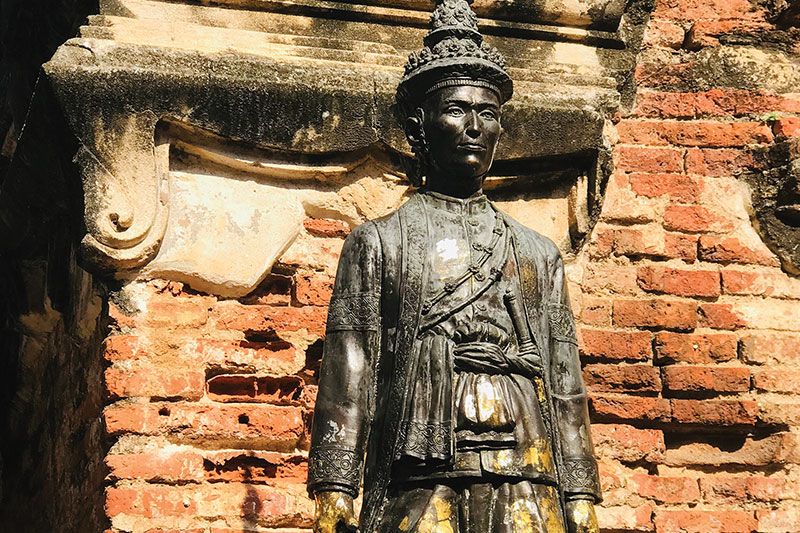
Lop Buri has been a haven for these creatures since ancient times. According to legend, the roots of their presence can be traced back to the Ramayana, the classic Indian epic. In the aftermath of Rama’s victory over Ramayana (Thossakan), Hanuman, his loyal monkey warrior, was rewarded by being made king of Lop Buri. Accompanied by his troop of monkeys, the monkey king established Lawo, present-day Lop Buri, as their home.
The legend became entangled with King Narai of Ayutthaya of Rama (Vishnu). In 1665, King Narai built his second palace in Lop Buri, the “City of Hanuman”, to distance himself from the political intrigues and cold-blooded murders of the Ayutthaya court.
King Narai’s 17th-century palace is an architectural marvel blending Thai, Khmer, and European styles. Though it fell to ruins after the king’s demise, it remains a compelling destination, inviting exploration of its opulent halls, meticulously landscaped gardens, and ancient artefacts.
Close by, the King Narai National Museum traces the town’s history, art and local lifestyles, starting with extraordinary Buddha sculptures dating back to the 7th century.
King Narai’s reign transformed the tranquil “monkey town” into a fashionable destination for elites, including French diplomats during the 17th century.
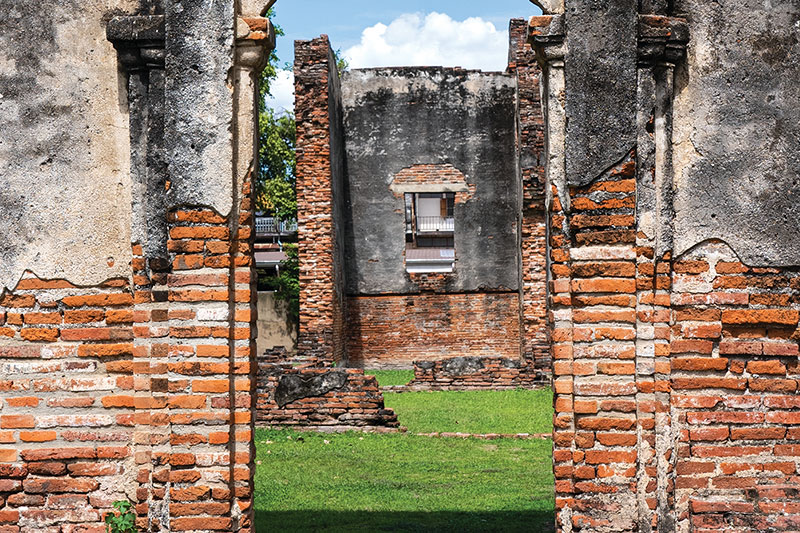
Constantine Phaulkon, a Greek adventurer-turned-minister, forged an unbreakable bond with King Narai from Wichayen House, his residence just 400 metres north of the palace. Here, you are immersed in the captivating tale of how fate led Phaulkon to the Siamese court and Lop Buri after his shipwreck in the 1760s. With his adept trading skills and proficiency in foreign languages, he ascended to the position of trade and foreign minister, becoming King Narai’s most favoured and influential officer. His grand European-style residence on Wichayen Road features a church and, of course, a wine cellar to host envoys from King Louis XIV of France.
As you explore the ruins of Wichayen House and wonder where the Burgundy was stored, you’ll discover that life dealt Phaulkon an abundance of twists and turns. A shipwreched Greek commoner, he managed to earn favour from the illustrious king of Siam and wed Maria Guyomar de Pinha, renowned as a great cook and also one of the most beautiful women in Ayutthaya. Phaulkon’s story took a tragic turn where he attempted to seize the throne and was executed for treason by Narai’s successor.
Lop Buri truly merits an extended stay, thanks to captivating tales and historical landmarks that weave a rich and immersive experience.
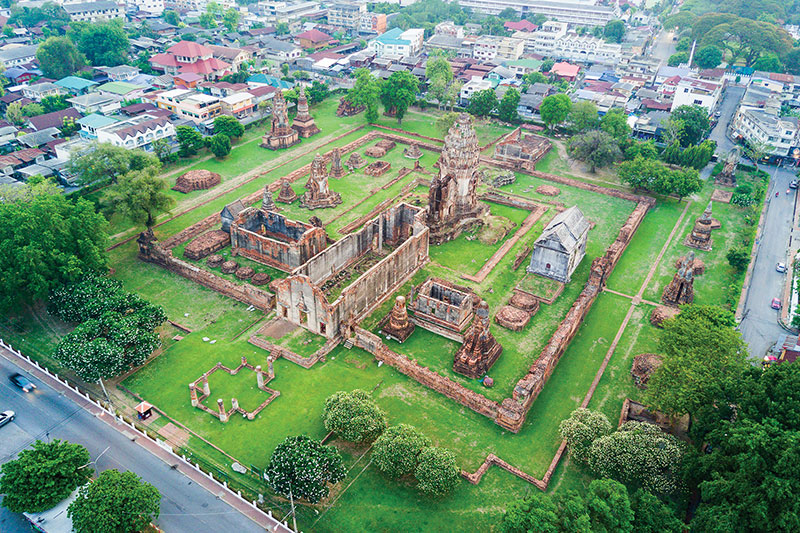
A brief stroll to the west of King Narai’s Palace leads to Wat Phrasi Rattana Mahathat, a remarkable Khmer-style temple. Built in the 12th century on a grand scale, this temple is a patchwork of preserved remnants from different historical periods. Notable is the Buddhist temple to the east of the pagoda, commissioned by King Narai. Its unique fusion of styles mixes Thai-inspired doors with Gothic windows that mirror the diverse cultural influences present during its construction.
Along with historical gems, Lop Buri is also endowed with natural riches.
At Khao Chin Lae Mountain, located 23 kilometres east of the town, sunflower fields burst into bloom from November to January. Standing amid endless expanses of vibrant yellow flowers stretching to the mountains and azure sky creates a stunning backdrop for your adventure.
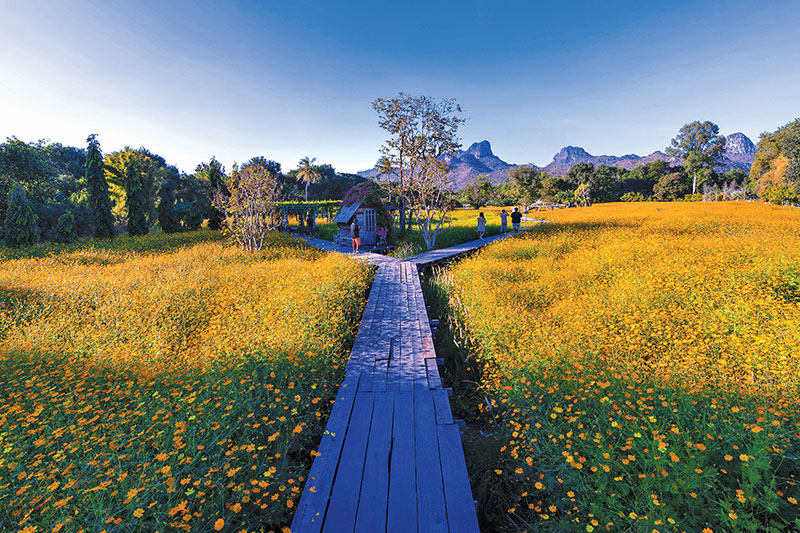
Basil & Coffee is situated amid fields of cosmos flowers a 10-minute drive away. This relaxed eatery serves classic Thai dishes like spicy holy basil-flavoured stir-fries alongside European favourites like salmon steak. Diners can stroll along the elevated walkway for selfies with the charming wooden cottage set amid the wildflower meadow.
Lop Buri’s culinary scene reflects the melting pot of local ethnicities and cultures, ranging from Thai Phuan to Mon.
On Phrasi Mahosot Road is Mudmee, a renowned Thai Phuan restaurant that counts Thai royals among its clientele. Signature dishes here are Stir-Fried Crispy Catfish with Salted Egg, Puffball Mushroom Curry, Friend Chicken with Herbs, and Deep-Fried Whiser Sheatfish with Garlic.
Whether you’re a history enthusiast, a wildlife lover, or a foodie seeking new flavours, Lop Buri has something special to offer, making it a must-visit destination for those exploring the wonders of Thailand.
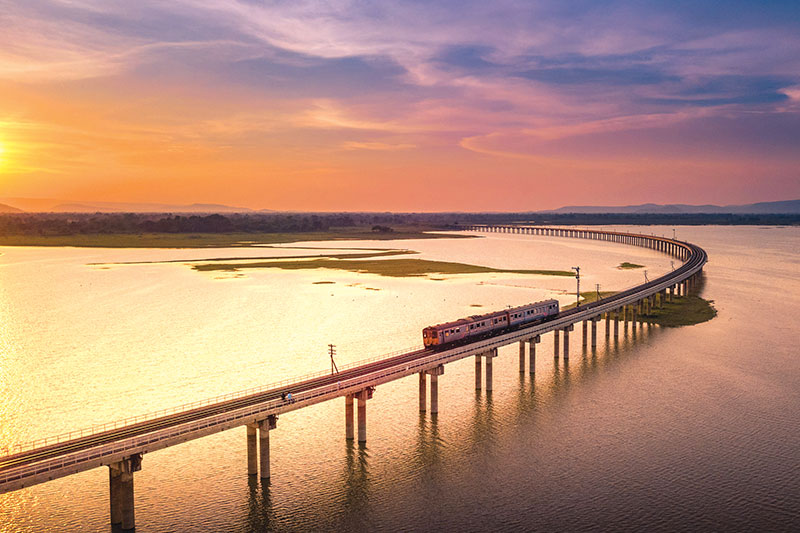
Scenic Train Ride
Roundtrips on the famous “floating train” tourist service run from Bangkok to scenic Pa Sak Jolasid Dam in Lop Buri province from November to January. The train is named for the illusion of gliding over the water as it traverses the dam on the tranquil reservoir. Adding a touch of authenticity this year is the vintage 1980 KiHa-183 train, a retired “workhorse” now serving tourists. Celebrated as one of Thailand’s most picturesque train rides, the Pa Sak Jolasid Dam route features an enticing side excursion to breathtaking sunflower fileds. The pinnacle of the journey, however, is witnessing the sunset over the reservoir from the classic KiHa-183. Tickets for this enchanting ride can be secured at all train stations throughout Thailand For additional details, please call 1690, www.dticket.railway.co.th
